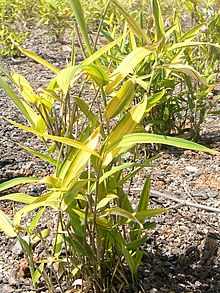Pleioblastus
| Pleioblastus | ||||||||||||
|---|---|---|---|---|---|---|---|---|---|---|---|---|

Pleioblastus simonii in winter |
||||||||||||
| Systematics | ||||||||||||
|
||||||||||||
| Scientific name | ||||||||||||
| Pleioblastus | ||||||||||||
| Nakai |
Pleioblastus is a genus from the Arundinarieae tribe , the woody bamboo species from the temperate climate zone .
description
The species of the genus are perennial , rather small and grow like a bush or tree. The rhizomes are leptomorphic , i.e. long and more or less unbranched ( monopodial ). The stalks grow more or less upright to hanging in several clusters. They reach a height of 0.5 to 8 meters and a diameter of 0.1 to 4 centimeters. The nodes are thickened. The internodes are hairless, smooth or rough, slightly furrowed above the node and frosted below the node. The branch buds are large, the associated bracts keeled twice. Depending on the species, one, two, three or up to nine long branches are formed per bud, with one dominant or all of them being approximately the same thickness. The straw sheaths are permanent and almost leathery. The leaf blade is often bent back and falls off early. The leaves are permanent, the leaf blades are small to medium-sized. They can show transverse leaf veins. The leaf margins usually survive the winter without parts dying off.
The inflorescences are open and racemose to panicle-shaped . The side branches show small bracts or hairs at the base . The spikelets grow on long, thin stems, are 1 to 4 inches long and have four to eight florets . The one or two rarely to five glumes are thin, loose, stand at the base of rudimentary buds and are significantly shorter than the first lemma. The palea reaches a length of up to 1 centimeter. Three bald or ciliated erectile tissue and three stamens are formed per flower . The ovary is hairless and has three scars . The fruits are caryopses .
Distribution and ecology
The range of the species is in Asia (for example in China, Japan and Vietnam), in Australasia and on Pacific islands, where they can be found in the temperate climate.
Systematics and research history
Pleioblastus belongs to the tribe Arundinarieae . It was set up in 1925 by Takenoshin Nakai in the Journal of the Arnold Arboretum . Synonyms of the genus are Nipponocalamus Nakai and Polyanthus C.H.Hu.

The following species are assigned to the genus:
- Pleioblastus altiligulatus S.L.Chen & SYChen : Fujian , Hunan , Zhejiang .
- Pleioblastus amarus (Keng) Keng f. : Southern China.
- Pleioblastus argenteostriatus (rule) Nakai : South-central and southern Japan.
- Pleioblastus distichus (Mitford) Nakai : Japan.
- Pleioblastus fortunei ( Van Houtte ) Nakai : Central and southern Japan.
- Pleioblastus glabrinodus G.H. Lai : The species first described in 2012 occurs in Anhui .
- Pleioblastus gramineus (Bean) Nakai : It occurs on the Nansei Islands .
- Pleioblastus guilongshanensis M.M.Lin : Fujian .
- Pleioblastus hattorianus Koidz. : Honshu .
- Pleioblastus hsienchuensis T.H.Wen : Zhejiang.
- Pleioblastus incarnatus S.L. Chen & GYSheng : Fujian.
- Pleioblastus kodzumae Makino : Kyushu .
- Pleioblastus linearis (Hack.) Nakai : Nansei Islands .
- Pleioblastus maculatus (McClure) CDChu & CSChao : Central and Southern China.
- Pleioblastus matsunoi Nakai : Honshu.
- Pleioblastus nagashima (Mitford) Nakai : Honshu and Kyushu.
- Pleioblastus pseudosasaoides Sad.Suzuki : Central Honshu.
- Pleioblastus rugatus T.H.Wen & SYChen : Zhejiang .
- Pleioblastus sanmingensis S.L. Chen & GYSheng : Fujian.
- Pleioblastus simonii (Carrière) Nakai : Central and southern Japan.
- Pleioblastus solidus S.Y.Chen : Jiangsu , Zhejiang.
- Pleioblastus truncatus T.H.Wen : Zhejiang.
- Pleioblastus viridistriatus (rule) Makino (Syn .: Pleioblastus kongosanensis Makino ): Central and southern Japan.
- Pleioblastus wuyishanensis Q.F. Zheng & KFHuang : Fujian.
- Pleioblastus yixingensis S.L.Chen & SYChen : Jiangsu .
literature
- Wu Zheng-yi, Peter H. Raven, Deyuan Hong (Eds.): Flora of China . Volume 22: Poaceae . Science Press / Missouri Botanical Garden Press, Beijing / St. Louis 2006, ISBN 1-930723-50-4 , pp. 121 (English).
- Andreas Roloff , Andreas Bärtels: Flora of the woods. Purpose, properties and use. With a winter key from Bernd Schulz. 3rd, corrected edition. Eugen Ulmer, Stuttgart (Hohenheim) 2008, ISBN 978-3-8001-5614-6 , p. 698.
- Simon Crouzet, Oliver Colin: Bamboo . Österreichischer Agrarverlag, 2003, ISBN 3-7040-1952-6 , p. 75 .
Individual evidence
- ↑ a b c Zheng-de Zhu, Chris Stapleton: Pleioblastus In: Flora of China. Volume 22, p. 121.
- ↑ a b c W. D. Clayton, M. Vorontsova, KT Harman, H. Williamson: Pleioblastus. In: GrassBase - The Online World Grass Flora. Royal Botanic Gardens, accessed February 24, 2015 .
- ^ Pleioblastus in the Germplasm Resources Information Network (GRIN), USDA , ARS , National Genetic Resources Program. National Germplasm Resources Laboratory, Beltsville, Maryland.
- ↑ Pleioblastus. In: The International Plant Name Index. Retrieved February 24, 2015 .
- ↑ a b c d e f g h i j k l m n o p q r s t u v w x y z Rafaël Govaerts (Ed.): Pleioblastus. In: World Checklist of Selected Plant Families (WCSP) - The Board of Trustees of the Royal Botanic Gardens, Kew . Retrieved August 23, 2018.
